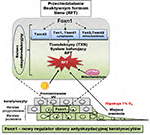Epidermal factor Foxn1 as a regulator of antioxidant defense in the skin
DOI:
https://doi.org/10.18388/pb.2021_503Abstract
The skin, as the largest organ of the body, is constantly exposed to environmental threats, including: injuries and oxidative stress. The thioredoxin system is one of the skin antioxidant systems , which protects cells against oxidative stress, regulates cell migration, proliferation and apoptosis, and also participates in signal transmission by regulating the activity of transcription factors. Recent studies have shown a correlation between the epidermal transcription factor Foxn1 and the thioredoxin system in mouse skin. Mass spectrometry analysis, followed by in vitro and in vivo experiments, showed that Foxn1 in keratinocytes regulates elements of the electron transport chain as well as the thioredoxin system (Txn2, Txnrd3), especially under hypoxic condition. High levels of Txnrd3 mRNA were detected for the first time in the injured skin of Foxn1+/+ mice compared to Foxn1-/- mice, and also showed that Foxn1 in keratinocytes upregulates Txnrd3 protein expression. Moreover, in silico analyzes indicated possible binding sites of the transcription factor Foxn1 in the Txn system. In conclusion, the data presented in this review identify Foxn1 as a novel component of the skin antioxidant system.

Published
Issue
Section
License
Copyright (c) 2023 Sylwia Machcińska-Zielińska, Barbara Gawrońska-Kozak

This work is licensed under a Creative Commons Attribution 4.0 International License.
All journal contents are distributed under the Creative Commons Attribution-ShareAlike 4.0 International (CC BY-SA 4.0) license. Everybody may use the content following terms: Attribution — You must give appropriate credit, provide a link to the license, and indicate if changes were made, ShareAlike — If you remix, transform, or build upon the material, you must distribute your contributions under the same license as the original. There are no additional restrictions — You may not apply legal terms or technological measures that legally restrict others from doing anything the license permits.
Copyright for all published papers © stays with the authors.
Copyright for the journal: © Polish Biochemical Society.



